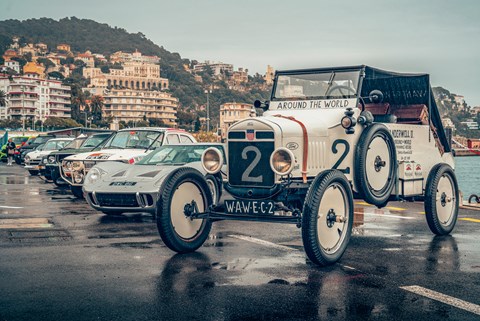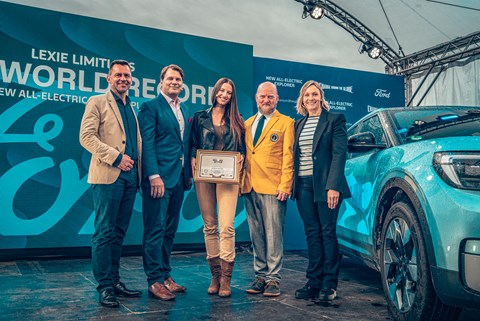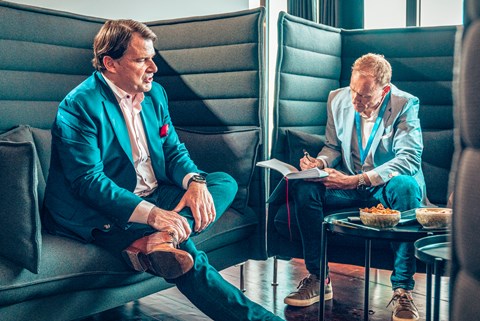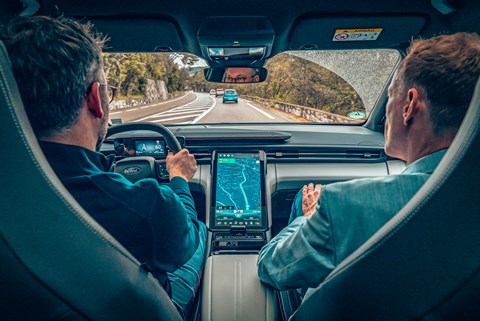► CAR interviews Ford boss Jim Farley
► Ford and Europe relationship status: it’s complicated
► How will Farley rekindle our love of the brand?
Jim Farley’s company jet will be on the ground in Nice for less than 24 hours but the Ford CEO is determined to put his mark on this major moment, albeit fleetingly. ‘Explorer is an important one for us,’ is his opening remark to CAR.
To back up the rhetoric, Ford has driven its first European-designed and -built electric car around the world. With travel influencer Lexie Alford – who blogs and makes videos as Lexie Limitless – at the wheel, the Explorer has covered 18,830 miles on six continents to become the first EV to circumnavigate the globe. Today Lexie, her Explorer and the boss cross the finish line to mark the car’s commercial introduction.
Ford is making a big deal out of this all-guns-blazing PR stunt: you can’t move for Ford-badged employees and dealers in the port-side hospitality area, and Ford is streaming the climax to its workforce. The dismal weather barely dampens the enthusiasm.

A convoy of amazing and eclectic Ford heritage vehicles are here – from a replica of the Model T that became the first car to circumnavigate the globe a century ago, through Mustangs and GTs to the electric F-150 Lightning and Mustang Mach-E that embody contemporary Ford – reminding us of the cars that made the Blue Oval matter.
On stage Farley demonstrates his car-nut credentials, firing off vignettes to the crowd as he recounts the GT40’s racing pedigree (‘you’ve got to love GT40s – what a beautiful car’), telling the 1967 Bullitt car’s backstory (‘it was the first big-block Mustang, so great at burn-outs!’) and joking about how a mid-engined RS200 Group B rally car ended up in Essex police livery. ‘That’s forbidden fruit in the USA,’ he mutters, sounding like he fancies putting that right one day.
And that’s the crux of this rose-tinted show of strength: Farley’s strategy is to make passenger cars that tap into the DNA of Ford’s big hits to reignite customer passions.

‘We’re getting out of the boring-car business and into the iconic-vehicle business,’ he tells me. ‘We’d always competed at the heart of the passenger-car market, which didn’t work out too well for Mondeo, Focus and Fiesta. They were loved by a lot of customers but they could never justify more capital allocation – unlike commercial vehicles.’
Farley believes the Puma, developed when he ran Ford of Europe, Africa and the Middle East from 2015 to 2017, epitomises his new strategy. Combining a popular body style with a winning design, a beloved name plate and a higher price to boost margins, the small SUV was the UK’s best-selling car last year – and the Transit family the top-seller overall.
The UK is ‘kind of a home market’, the CEO reckons, although VW usurped it as the biggest-selling brand during the Covid-19 era, a situation that won’t be reversed as Ford switches from a car-for-everyone approach to more upmarket, carefully targeted vehicles.
Fiesta production was phased out of the Cologne plant last summer, in a $1 billion refit to manufacture the electric Explorer and its sibling, the new Capri. Pointedly Jodie Kidd drove a 1972 RS 2600 version of ‘Europe’s Mustang’ in the Lexie Limitless convoy. The Focus – represented by the Mk1 RS, the ultimate fast Ford badge, and one that Farley hints will return on future cars – will bow out of production in 2025.
‘We’re naturally good at fast Fords and Broncos and authentic off-roaders,’ he explains. ‘Ford’s brand perception was the same around the world: we were a ubiquitous company. But we had these little areas of brightness: we have heritage centres around the world filled with these [great] vehicles, but they were never mainstream.
‘Take Raptor: it came from desert racing in Mexico and we made it global and mainstream.’ With jacked-up ride height, beefed-up suspension and big engines, there are now Raptor versions of the F-150 pick-up, Europe and Australia’s Ranger pick-up and the Bronco SUV. ‘The Raptor story is a great example of where I think our passenger cars should go.’

Warming to his theme, Farley continues: ‘We can take on Porsche with Mustang – it’s the best-selling sports coupe in the world. We’re going to invest in that brand and get stronger and stronger.’
Hence the dollars being wildly hosed at motorsport, from Ford’s return to F1, powering Red Bull in 2026, to long-standing World Rally Championship interest, to off-road racing Broncos, to the Mustang’s assault on Le Mans this year. The hall-of-fame convoy includes a Mustang Dark Horse, which sired the FIA GT3 racer, which in turn inspired the hot Mustang GTD road car. With 800 horsepower, part-carbonfibre body and an outrageous aero kit to glue it down, the GTD will have a six-figure price and the scent of Porsche GT cars in its nostrils.
‘Ford never funded enthusiast products – they were always a side business. Now with Mustang, Raptor and Bronco, they’re our business,’ says Farley. He’s one of those leaders who likes to listen as well as talk, for instance sounding me out on whether Bronco could compete with Land Rover in the UK. ‘The big Bronco will do right-hand drive and I think it’s worth a try,’ he muses. Then he chuckles: ‘We had a break-up with a marriage there,’ referencing Ford’s sale of Land Rover to Tata in 2008. ‘The next step is to go dating again, right?’
Before then, this August, the UK gets the Explorer EV. The mid-size SUV’s hardware is Volkswagen Group’s MEB electric-car platform, a deal signed the year before Farley moved offices from COO to CEO.
Two ‘extended range’ Explorers are being offered at launch, one rear-wheel drive, the other four-wheel drive. The £45,875 rear-drive version packs a 77kWh usable battery and a 210kW motor (282bhp). It’s almost Focus ST quick: 0-62mph takes 6.4sec, dropping to 5.3sec for the twin-motor Explorer. This has a combined peak power of 250kW (335bhp) fed by a fractionally bigger 79kWh pack.
Those powertrains largely mirror VW’s, though Ford reckons its fine-tuning has delivered figures that are (for now) class-leading: the RWD’s 374 miles of range, and the AWD’s 26-minute charge time (from 10 to 80 per cent on a 185kW DC charger). Those are the details that matter to car buyers, not who supplies the battery, insists European design director Amko Leenarts when I mention the lack of Ford proprietary technology.
His design team have done a splendid job stamping Ford’s identity on the MEB underpinnings, not just by chopping 120mm out of the rear overhang and shrinking the boot to 450 litres. The bluff sides give presence, the clean surfaces modernity and the blacked-out pillars, including a rearward ‘sail’ graphic, make a visual connection with America’s bigger (non-electric) Explorer SUV.

I take a brief passenger ride on the damp roads around St Paul de Vence. The commanding seating position feels authentic SUV, and there’s a long overdue improvement in Ford interior design. All Explorers get a two-tone dashboard, seats trimmed in sporty, leather-free Sensico and a prominent, 14.6-inch vertical touchscreen, its interface familiar from Mach-E not ID. 3. The screen manually pivots by 30˚ to adjust visibility and uncover a clever storage area to hide valuables; owners will welcome the huge armrest stowage too.
Beneath, thunking manhole covers and jarring tarmac ridges are relayed to the cabin by taut suspension, which reins in bodyroll and float. There’s an engaging electric-motor whine as the Extended AWD spins eagerly up to speed, and murmuring from the Continental tyres. Springs, dampers and anti-roll settings are bespoke.
Partnering with Volkswagen helped Ford get a European-sized EV to market two years quicker than going it alone. But Jim Farley flatly refuses to answer whether the MEB co-operation will be extended, instead talking about Ford Otosan, ‘our best partnership globally’.
This commercial-vehicle venture with huge Turkish conglomerate Koç Holding embraced Volkswagen as part of the MEB deal, so VW’s new Amarok pick-up is a rebadged Ford Ranger and the Transporter and Transit are being pooled. ‘In commercial vehicles, Ford is the number one brand in Europe and the US. Man, we’re just great at work vehicles,’ he enthuses.
But a proposed Turkish battery gigafactory has been shelved. Has President Biden’s Inflation Reduction Act (IRA), with its huge subsidies for home-grown electrification initiatives, sucked Ford’s investment in batteries and vehicle platforms back to the US?
‘The US has never had an industrial policy like Europe, Japan or China; the IRA was one of the first. And it’s changed the math for manufacturing batteries and for customers looking at EVs,’ the CEO replies. ‘But despite all that, customers have many uncertainties regardless of what a manufacturer wants their line-up [to be] or what regulators in Brussels want.’ Those uncertainties include resale values, energy costs and charging on long road trips, he reckons.

This is the turbulence through which Farley must pilot Ford. An airspace where government policy can upend plans for good or ill, where electrification invites new rivalries. ‘The Chinese brands are coming to Europe and they’re incredibly fit competitors. In the EV business, Tesla and the Chinese are our main competition.’ All the while customer desires are fragmenting, heaping extra pressure and costs on car makers. ‘We make [America’s] best-selling ICE vehicle – the F-150 – also as a hybrid and EV. In California, 85 per cent of F-150 sales are electric or hybrid. In Texas 85 per cent are combustion!’
Amid that uncertainty, he’s got to make the call if vehicle platforms should be pure electric or multi-energy, made in partnerships such as the Explorer’s or developed in-house. And it sounds like the MEB partnership is very much a short-term play.
‘If your bet is the digital experience as a differentiator, you can’t use someone else’s electric architecture. If I use MEB, then another architecture in China, one in North America and another for export, that’s multiple different software. Software that has to be written to the individual module for propulsion, braking, steering, seats. If [Ford] is very committed to digital differentiation, it’s impossible to have that complexity.
‘One of my biggest bets as CEO is our platforms, including our electric architectures. There will be places where we work with each other, such as MEB. But in the future that will be harder, not easier.’
From a purist’s perspective, that sounds like a good thing. For Fords to be distinctive and packed to the core with its finest DNA, creating EVs that shine like S-Max, Mk1 Focus or Fiesta ST for a new generation, it needs to rediscover its Midas touch. Then Europe might see the characterful cars Farley promises, icons for the 2020s and beyond.